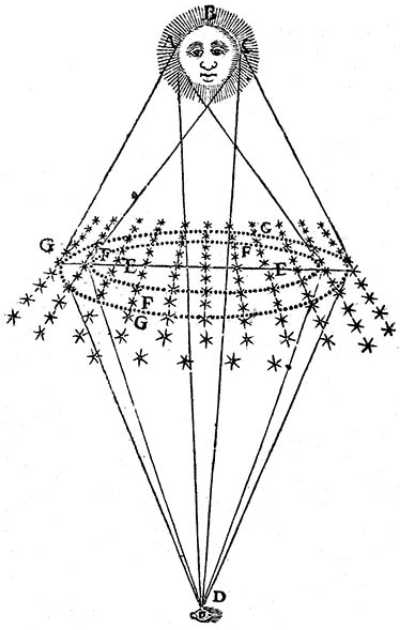The Circles Around the Stars
Table of Contents
Sometimes there are certain circles around the stars.
They are similar to the rainbow in that they:
- are round, or almost round
- always surround the sun or some other star
- are colored
It shows that:
- they are caused by some reflection or refraction whose angles are approximately equal.
- there is refraction and a shadow that limits the light that produces them.
A rainbow is:
- only seen when:
- it is actually raining in the direction where it is seen
- not raining where the observer is
- never seen when it rains where the observer is
This shows that it is not caused by the refraction in raindrops or hail, but by refraction in these little transparent ice crystals.
Heat makes them turn transparent, from being white.
- This is why summer is more suitable than winter for this effect.
Most of those that fall appear extremely flat and smooth.
- But they are actually thicker in the middle than at the ends.
These make these circles appear larger or smaller.
There are several sizes.
- Some have written that some circles have their diameter of around 45 degrees.
The ice particles that cause this size have the maximum convexity possible without completely melting.

Let:
ABCbe the sunDthe eyeEFGseveral small transparent ice particles, arranged side by side as they are in forming.
Their convexity is such that the ray coming from point A onto G, and from point C onto F, returns towards D.
Several others come towards D from points that that pass towards E but not beyond the circle GG.
The rays AD, CD, and similar, pass in a straight line.
- These make the sun appear its usual size.
The others are refracted towards EE makes the area in circle FF quite bright.
It makes its circumference between the circles FF, and GG, appear like a crown painted with the colors of the rainbow.
- The red there must be inside towards
F - The blue must be outside towards
G
If there are 2 or more rows of ice particles on top of each other that still allows the sun’s rays to pass through, the rays that pass through 2 of their edges will bend almost twice as much as the others.
This will produce another colored circle, much larger in circumference, but less apparent than the first.
In this way, one will then see 2 crowns one inside the other. The inner one will be the best painted.
These crowns do not usually form around stars that are very low towards the horizon.
This is because the rays then meet the ice particles too obliquely to pass through them.
Their colors are not as vivid because they are caused by much smaller refractions.
They appear more often around the moon and even sometimes appear around stars. This is when the interposed ice particles are only very slightly convex as to make them very small.
They do not depend on as many reflections and refractions as the rainbow.
This makes the light that causes them not so strong.
But often they appear only white, not so much for lack of light, but because the material they form is not entirely transparent.
2 refractions without any reflection can produce a rainbow in water drops.
- But then there is nothing to determine their diameter
- The light is not limited by shadow, as is required for the production of colors.
2 refractions with 3-4 reflections also produce rainbows.
- But their light is greatly weak and can easily be erased by that which is reflected from the surface of the same drops.
- This makes me doubt if they ever appear.
- The calculation shows that their diameter should be much larger than what we find in those that are usually observed.